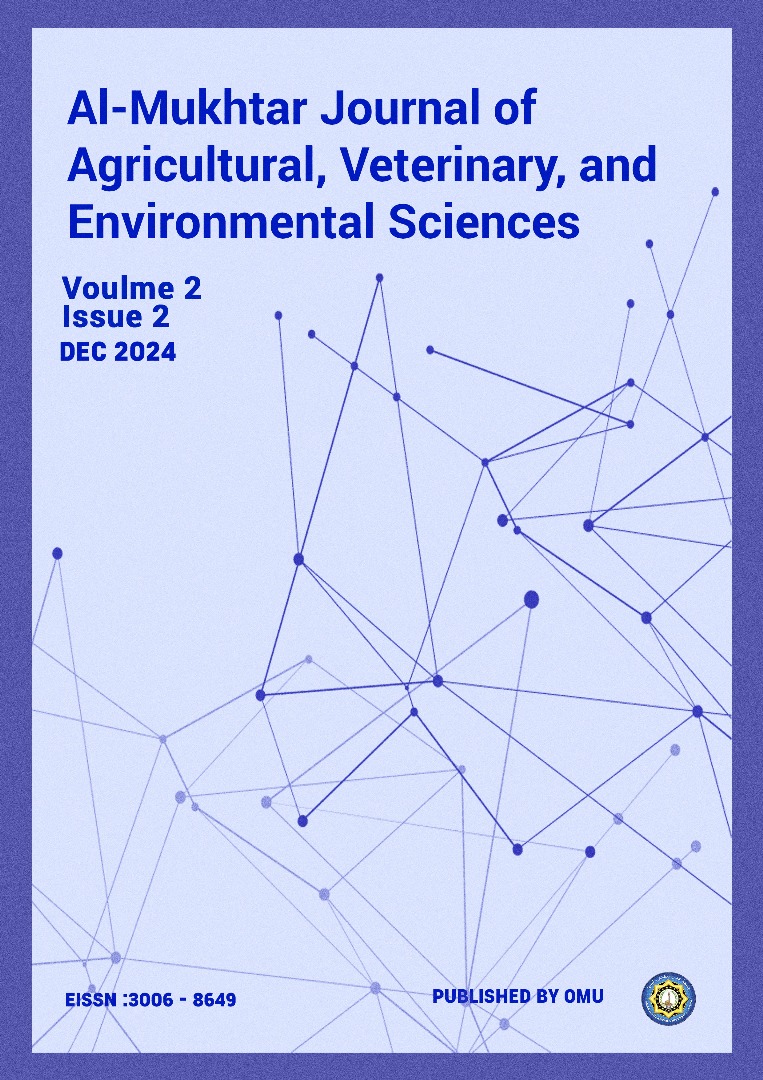Estimating some Genetic parameters of growth indicators & yield for Pure Lines of Chili pepper
DOI:
https://doi.org/10.54172/xes59r12Keywords:
Chili Pepper, Phenotypic Variation, Genetic Variation, HeritabilityAbstract
This research was conducted at the Talhadia Research Station during the 2022 season to evaluate the performance of some local chili pepper lines in Aleppo Governorate & to investigate the heritability, genetic, & phenotypic variation of their productive traits. The goal was to utilize these findings in breeding programs & to preserve the local genetic resources. The study included 22 local chili pepper lines, focusing on phonological phases, such as the number of days from transplanting until 75% of the plants flowered, the time to fruit setting (node formation), & the time to the first harvest, in addition to the length of the harvesting period. Plant traits such as plant height, the number of main branches, fruit length, fruit diameter, average fruit weight, fruit wall thickness, & plant productivity were also evaluated. The experiment was carried out using a R& omized Complete Block Design (RCBD) with three replications. The results revealed significant differences among the chili pepper lines in phonological stages & plant traits. Substantial variation was observed in plant height & the number of main branches among the lines. Genetic factors were found to have a greater influence than environmental factors on fruit characteristics & plant productivity. Heritability estimates ranged from 97% for fruit weight to 67% for fruit wall thickness & plant productivity. Cluster analysis grouped the studied lines into two main categories based on fruit & plant traits. The first category was further divided into two subgroups comprising nine strains, while the remaining strains were grouped into the second category. This research provides valuable insights for breeding programs & strategies aimed at improving chili pepper traits & preserving local varieties.
References
البياتي، حازم محمود حميد (1997). مكونات تحليل التباين الوراثي للحاصل ومكوناته في القطن الابلاند. المؤتمر العلمي السادس لهيئة المعاهد الفنية، البحوث الزراعية: 108 – 299 ص.
المجموعة الإحصائية الزراعية السنوية(2023). وزارة الزراعة والإصلاح الزراعي. مديرية الإحصاء والتخطيط.
منظمة الأغذية والزراعة للأمم المتحدة، 2010- إيقاف فقدان الموارد الوراثية النباتية. http://www.fao.org/nr/cgrfa/ctheme/ar
Belay F., Abate B., & Tsehaye Y. (2019). Genetic Variability & Characters Association in Hot Pepper (Capsicum annuum L.) Genotypes in Central Zone of Tigray, Northern Ethiopia. Journal of Biology, Agriculture & Healthcare www.iiste.org ISSN 2224-3208.
Bosl& , P. W. & Votava, F. J., .(2002).Peppers, vegetable & spice capsicums. CABI Publishing, p. 204 (2000).
Datta, S., & Das, L. (2013). Characterization & Genetic Variability Analysis in Capsicum annu-um L. Germplasm. SAARC J. Agri., 11(1): 91-103 (2013).
Drvoshanova, B., Ivanovska S., Jankulovska, M., Popsimonova, G. (2022). Variation of Fruit Morphological Traits in Capsicum annuum L. Germplasm Collection from North Macedo-nia. Journal of Agricultural, Food & Environmental Sciences Vol 76 No 1 (2022) 26-33.
Ellegren, H & Galtier, N. (2016). Determinants of genetic diversity. Nature Reviews Genetics volume 17, pages 422–433.
FAOSTAT data, (2024) "last updated January 18, 2024". http://faostat.fao.org/ AOSTAT Database Results.htm.
Farwah, S., Hussain, K., Rizvi, S., Hussain, Syed M., Rashid, M., & Saleem, S. (2020). Genetic variability, heritability & genetic advance studies in chilli (Capsicum annuum L.) geno-types. International Journal of Chemical Studies 2020; 8(3): 1328-1331
Hussein. I. A. & Mahdi. Sh. S., .2017. Genetic Variation in Bell Peppers (Capsicum annuum L.) Collected from Iraqi Local Markets by Using AFLP Marker. 8th International Conference on Agricultural, Environment, Biology & Medical Sciences. ISBN 978-93-86878-07-6.
Johnson, H. W., H. F. Robinson & R. E. Comstock. (1955). Estimates of genetic & environmen-tal variability in Soya Bean. Agron. J., 47: 318-324.
Lahbib K., Bnejdi F., & El Gazzah M. (2013). Genetic diversity evaluation of pepper (Capsicum annuum L.) in Tunisia based on morphologic characters. Afr. J. Agric. Res.
López Castilla, L. del C., Hernández, R. G., de la Cruz Castillo Aguilar, C., Martínez-Hernández, A., Ortiz-García, M. M., & & ueza-Noh, R. H. (2019). Structure & genetic diversity of nine important l& races of Capsicum species cultivated in the Yucatan Peninsula, Mexico. Agronomy, 9(7),376
Martínez-Ispizua, E., Calatayud, Á., Marsal, J. I., Mateos-Fernández, R., Díez, M. J., Soler, S., Valcárcel, J. V., & Martínez-Cuenca, M.-R. (2022). Phenotypic Divergence among Sweet Pepper L& races Assessed by Agro-Morphological Characterization as a Biodiversity Source. Agronomy 12, 632
Nankar, A. N., Todorova, V., Tringovska, I., Pasev, G., Radeva-Ivanova, V., Ivanova, V., & Kos-tova, D. (2020). A step towards Balkan Capsicum annuum L. core collection: Phenotypic & biochemical characterization of 180 accessions for agronomic, fruit quality, & virus re-sistance traits. PLoS ONE, 15(8)
Patel, M.Z., Reddi, M.V., Rana, B.S. & Reddy, B.J. (1989). Genetic divergence in safflower (Car-thamus tinctorius L.). Indian J. Genet.49 (1): 113-118.
Patidar R., Kumar ., Jatav V., Sharma C.K., Maurya D & Dukpa P. (2023). STUDIES ON GENET-IC VARIABILITY, HERITABILITY & GENETIC ADVANCE IN HOT CHILLI (Capsicum annuum L.). An International Refereed, Peer Reviewed & Indexed Quarterly Journal for Applied science.
Santiago-Luna, E. G., Carrillo-Rodríguez, J. C., Chávez-Servia, J. L., Perales-Segovia, C., & He-redia-Garcia, E. (2018). Variation of plant & fruit traits in native mexican costeño pepper. Horticultura Brasileira, 36(3), 399–407.
Sharma, A., Kumcar, M., Kumar, N., Dogra RK & Kumari, S.(2019). Studies on Interrelationships among Yield & Yield Contributing Traits in Bell Pepper (Capsicum annuum L. var. gros-sum). Journal of Phcrmacognosy & Phytochemistry 2019; 8(2): 646-649.
Singh, R. K. & B. D. Chaudhary. (1977). Biometrical method in quantitative genetic analysis. Kamla Nagar, Delhi 110007. India.
Tchiegang, P., M. Fewou & V. K. Noutchougoue. (1999). Etude compare uelqes constituents chi-miquees de deux types de piment. pendant la conservation dans une saumure acid.J. of Food Engin, 42(2): 117-123.
Tomooka, N. (1991). Genetic diversity & l& race differentiation of mungbean, (Vigna radiataL.) Wilczek, & evaluation of its wild relatives (The subgenus Ceratotropics) as breeding ma-terials. Tech. Bull. Trop. Res.Centre, Japan No. 28. Ministry of Agriculture, Forestry & Fisheries. Japan.p. 1.
Vidyashree, A.B., Allolli, T.B., Ravi, Y. & Mulge, R., ((2018. Genetic Variability Studies in Byadagi Chilli (Capsicum annuum L.), Int. J. Pure App. Biosci. 6(5): 1120-1125 (2018).
Downloads
Published
License
Copyright (c) 2024 Lama Alloun, Shaemae Samou, Lava Mustafa, ِAziza Mardikhy (Author)

This work is licensed under a Creative Commons Attribution-NonCommercial 4.0 International License.













